These shiny Sweet Black Soybeans or Kuromame are an important dish of the Osechi Ryori meal of traditional Japanese New Year foods. Eating these beans symbolizes good health in the new year. They are sweet and slightly savory and can be quite addicting!
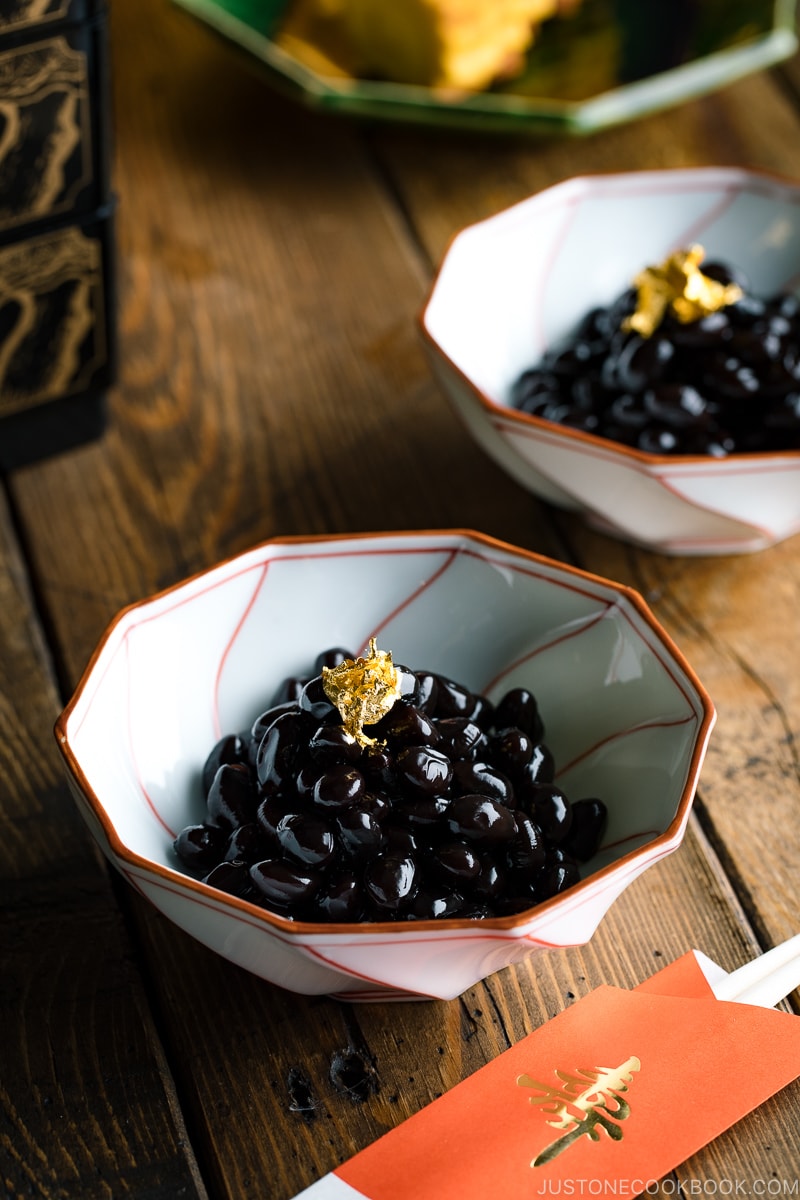
Kuromame (Sweet Black Soybeans) literally “black bean (黒豆)” in Japanese, and it is often served on New Year’s Day as a part of Osechi Ryori (traditional New Year’s meal). The shiny black beans are beautifully contrasting with red lacquer “jubako” (お重箱) container, which holds all different kinds of colorful traditional meals.
Eating kuromame is considered good for your health for the new year. My parents encouraged me to eat some kuromame on New Year’s Day but this is one of my favorite items among all the New Year’s dishes. Kuromame’s sweet and slightly savory flavor can be quite addicting.
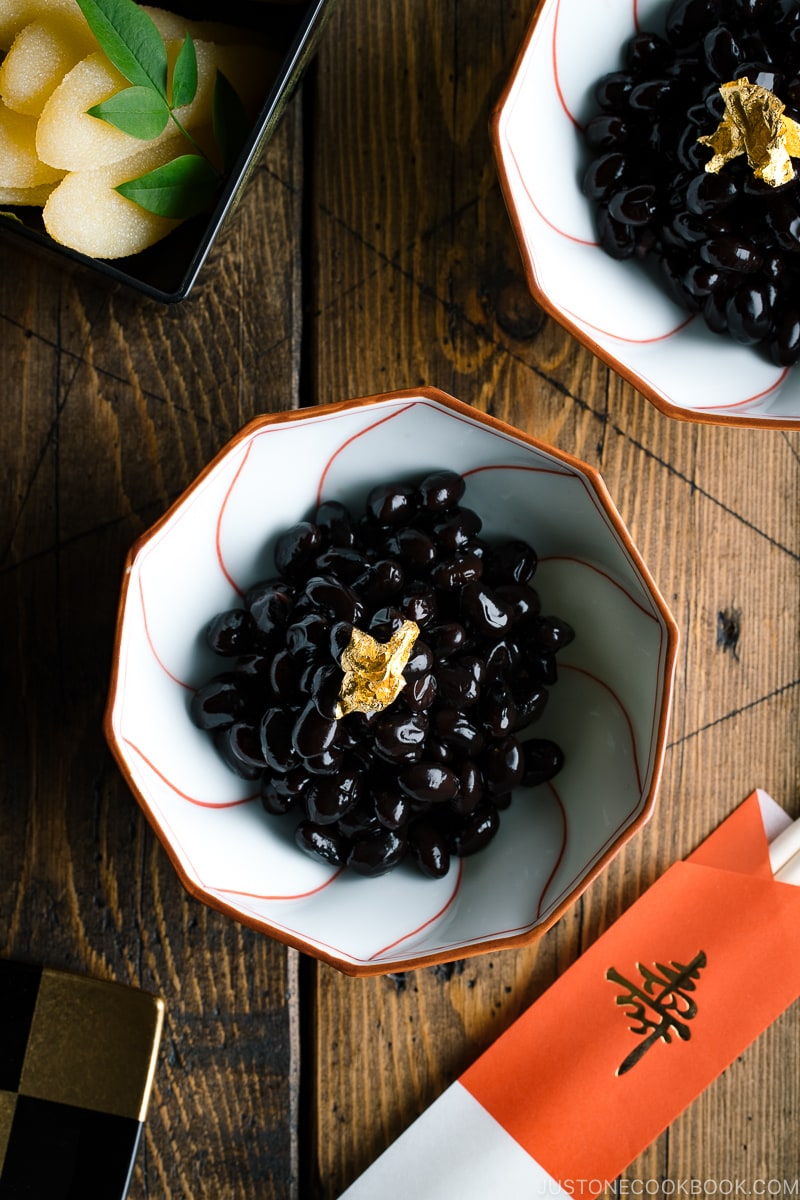
By the way, kuromame is black soybeans and not black beans. The kuromame recipe is pretty simple but the soybeans have to be soaked overnight and simmered on very low heat for a long time, some recipes say to cook on low heat for 8 hours!
I only cook for 4 hours till my black soybeans are tender. I use a heavy-bottomed cast iron pot, which retains heat very well. Please test the doneness of your black soybeans and adjust your cooking time.
If you have an Instant Pot or a pressure cooker, you can speed up the cooking process (15-minute high-pressure cooking!). Check out my Instant Pot Kuromame recipe.
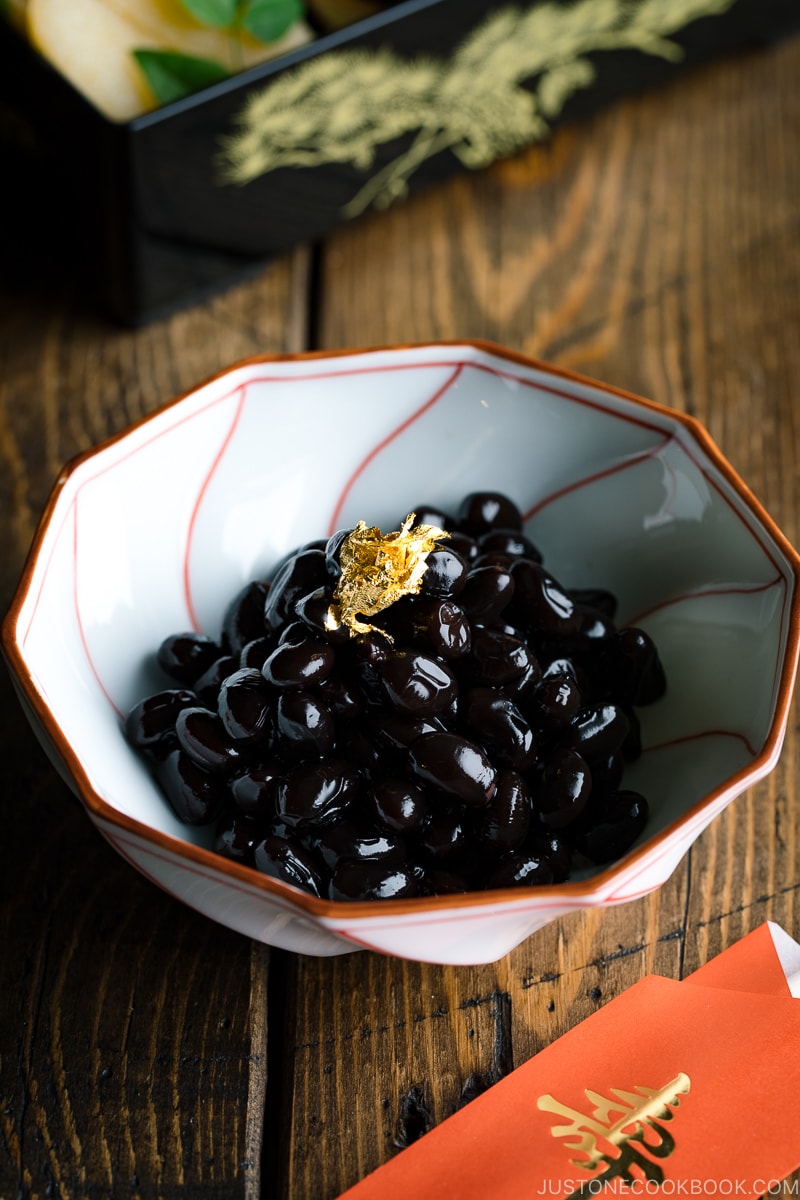
The Trick to Achieve Beautiful Black Color on Beans
Most of the traditional kuromame recipes require 2-3 “rusty” iron nails but it’s hard to find them! So in my recipe, I used Lucky Iron Fish that I purchased on Amazon.
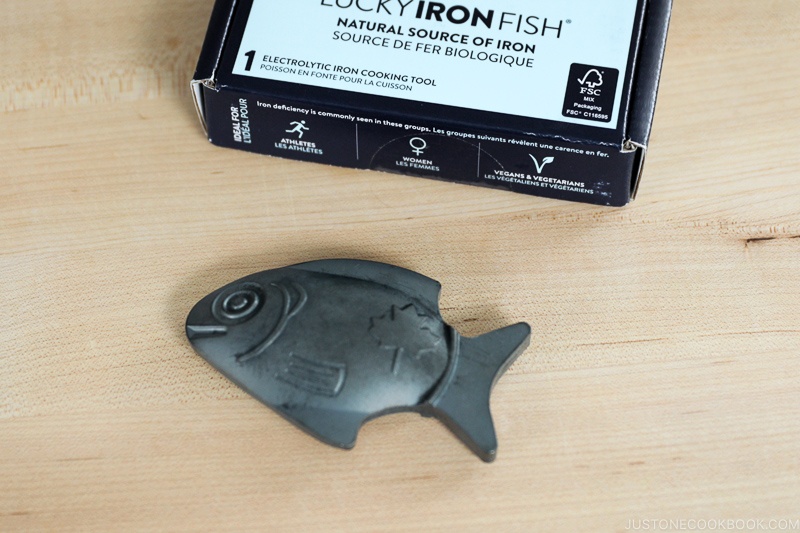
The reason why the Japanese put nails to cook kuromame is that rust (iron oxide) from nails has a chemical reaction with tannin in the beans, which helps the beans turn dark to a rich black color.
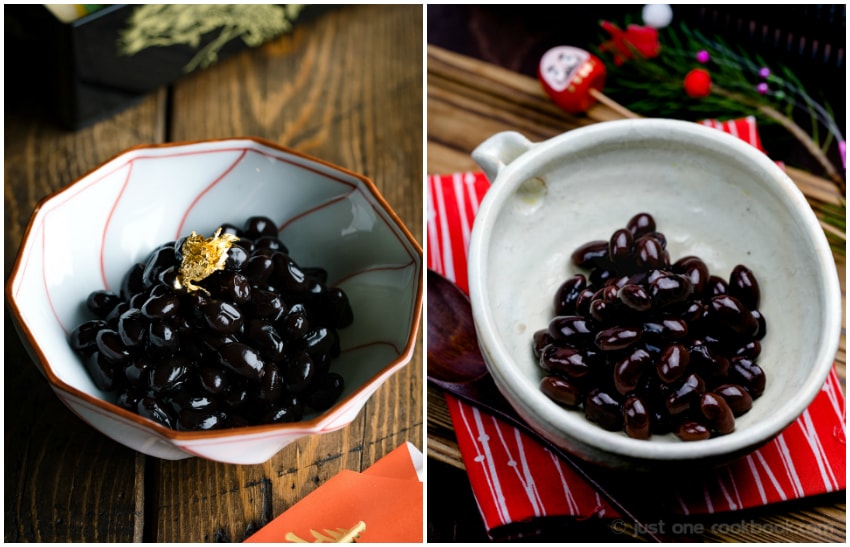
I hope this delicious kuromame will bring you health for the new year.
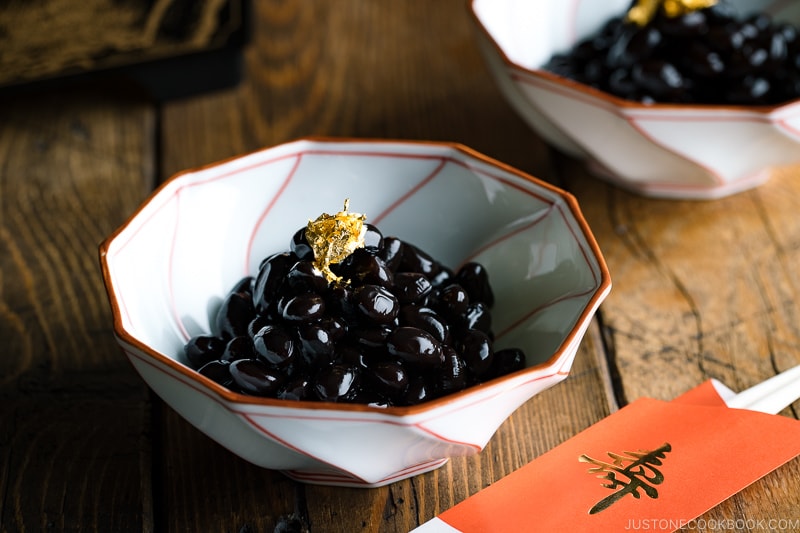
Pressure Cooker Kuromame
If you have an Instant Pot or a pressure cooker, check out my Instant Pot Kuromame recipe.
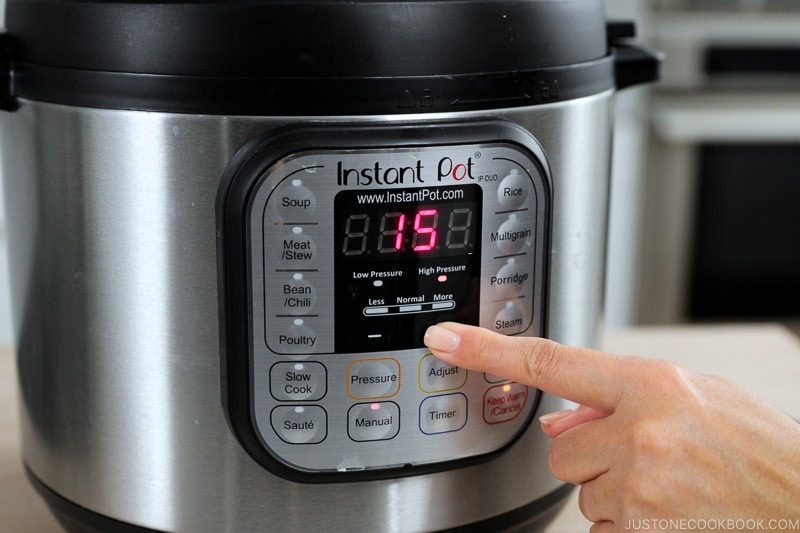
Wish to learn more about Japanese cooking? Sign up for our free newsletter to receive cooking tips & recipe updates! And stay in touch with me on Facebook, Pinterest, YouTube, and Instagram.

Kuromame (Sweet Black Soybeans)
Ingredients
- 7 oz kuromame (black soybeans) (dried)
- 5 cups water
- 1 cup sugar (7 oz; adjust the sweetness to your liking; typically, the ratio of black soybeans, sugar, and water is 1 to 1 to 6 by weight)
- ½ tsp Diamond Crystal kosher salt
- 1½ Tbsp soy sauce
For the Garnish
- edible gold leaf flakes (optional)
Instructions
Before You Start…
- Please note that this recipe requires a minimum soaking time of 4 hours for the dried beans; I also recommend a resting time of 8 hours once cooked, but this is not required. Please read and follow the package instructions for your black soybeans. My package directions say to soak for 4–5 hours, so I soaked them for 4 hours. For testing purposes, I tried soaking the same brand of soybeans overnight, and they came out a bit too soft. You may need to test to see how long you want to soak your soybeans.
- I recommend making this recipe 1–3 days before you plan to serve. For more helpful tips on planning your Japanese New Year feast, please read my A 5-Day Osechi Cooking Timeline blog post.
- Gather all the ingredients. You will need a large pot with a lid (I use a heavy-bottomed cast iron pot) and an otoshibuta (drop lid). If you don't have one, you can make an otoshibuta with aluminum foil. You will also need either 2–3 rusty iron nails wrapped in cheesecloth (the traditional method) or an Iron Fish (read why in the blog post). You can still make this recipe without the iron oxide from the nails or fish, but your soybeans may not turn a rich black color without it.
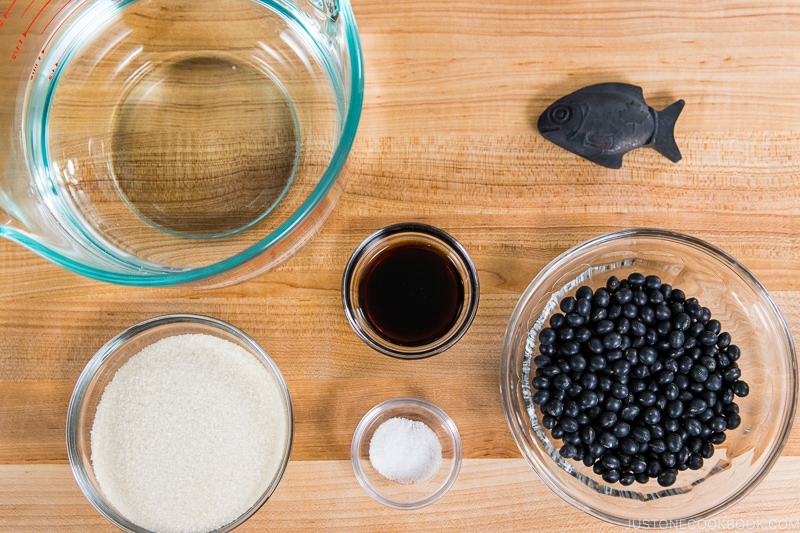
To Soak the Soybeans
- Gently rinse 7 oz kuromame (black soybeans) under cold running water. The skins are fragile, so handle with care. Some beans have skin that is partially peeled off, but you can use those in this recipe. Discard any damaged soybeans and drain well.
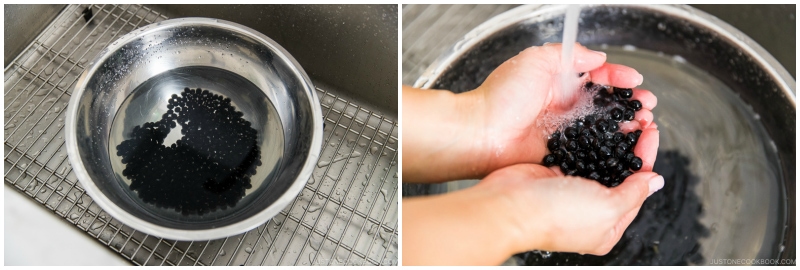
- In a large pot, add the soybeans, 5 cups water, and either the 2–3 cleaned rusty nails wrapped in cheesecloth or the Iron Fish. Depending on your package instructions, soak the soybeans for 4 hours or overnight on the counter in the wintertime (or in the refrigerator in the summertime and in warm climates).
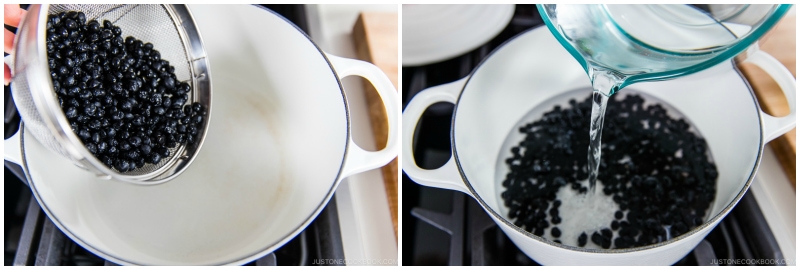
To Cook
- After soaking, add 1 cup sugar and ½ tsp Diamond Crystal kosher salt to the pot and gently mix. Keep the nails or Iron Fish in the pot.
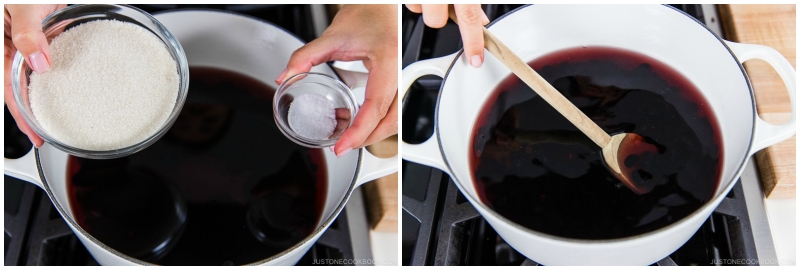
- Bring the pot of soybeans to a boil over medium heat.
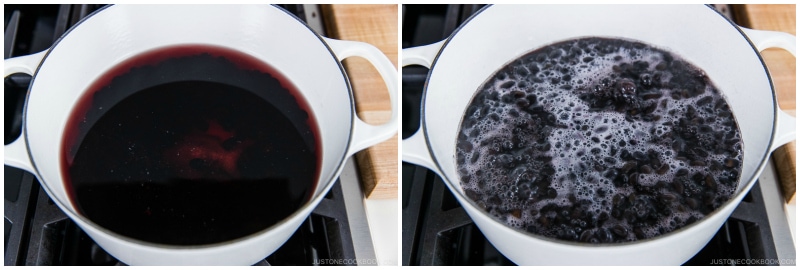
- Once boiling, thoroughly skim the white foam off the surface.
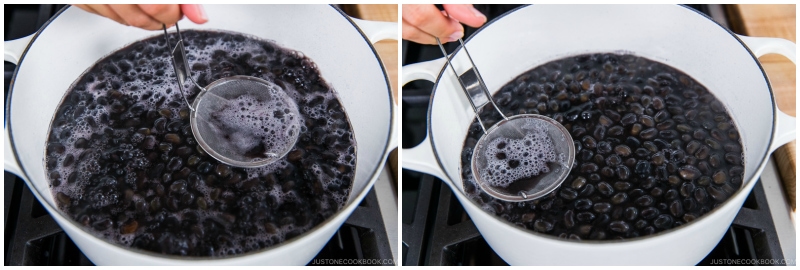
- When you‘re done skimming the foam, place an otoshibuta on the beans and cover the pot with a regular pot lid. The otoshibuta keeps the soybeans submerged under the cooking liquid and helps prevent their skins from getting dried and wrinkled. Next, reduce the heat to low and gently simmer (making sure the beans are not bouncing around) until the soybeans are tender, about 4 hours or longer.
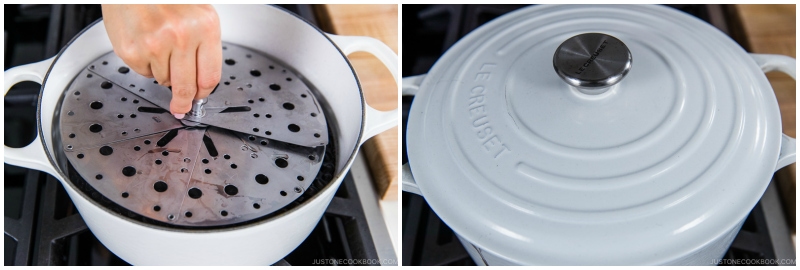
- Check inside the pot a few times to make sure there is enough cooking liquid to cover the soybeans. If not, add about 1 cup of water. Skim the surface of foam, if needed.
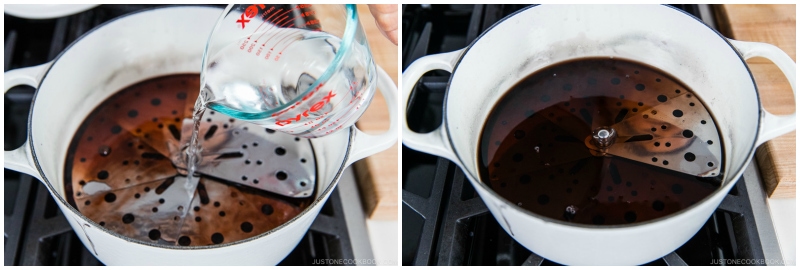
- Check if the beans are done cooking; they should be tender enough to mash between two fingers. When the beans are tender, remove the rusty nails or Iron Fish.
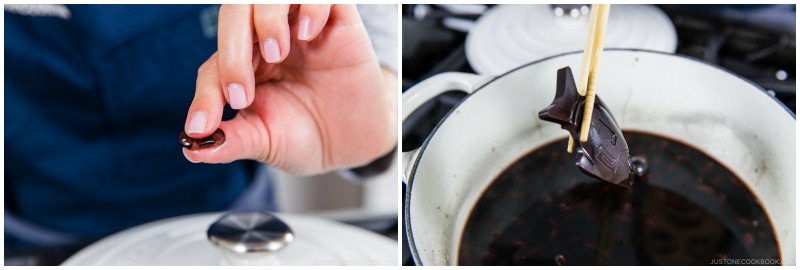
- Next, add 1½ Tbsp soy sauce and mix well. Then, remove the pot from the heat and allow to cool.
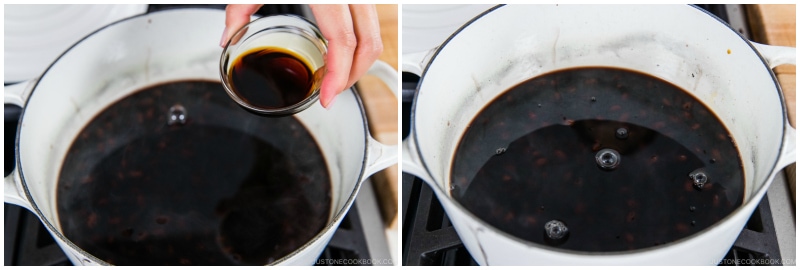
To Rest (recommended)
- Once cooled, the Kuromame are ready to eat. Place a piece of parchment paper on the surface of the soybeans to prevent them from getting dried and wrinkled. Once cooled, place the pot with the soybeans and parchment paper cover in the refrigerator for 8 hours or overnight so the soybeans will turn darker and absorb more flavor.
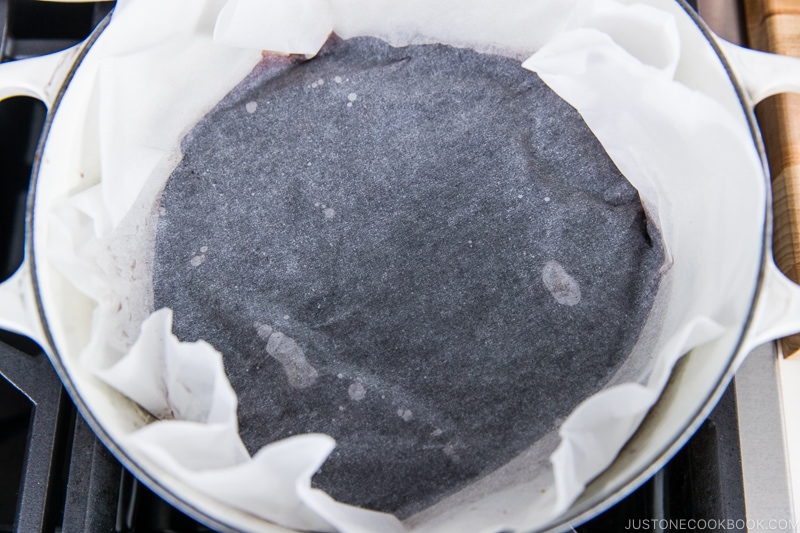
To Serve
- The following day, remove the pot from the refrigerator and transfer the soybeans and some of their cooking liquid to a storage container. (See my tips below for how to use the leftover cooking liquid.)
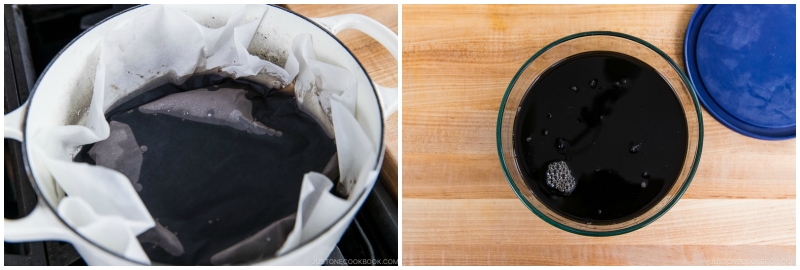
- Serve the Kuromame in a bowl without their cooking liquid. You can serve them either chilled or at room temperature. Garnish on top with edible gold leaf flakes (optional).

To Store
- Store the Kuromame in an airtight container, with enough cooking liquid to cover them, in the refrigerator for up to 4 days or in the freezer for up to a month.
To Use the Leftover Cooking Liquid and Kuromame
- You can use the leftover cooking liquid to make Oshiruko (Zenzai), black soybean latte, and jelly (using gelatin, agar, or kanten). You can use the leftover Kuromame to make pound cake and Steamed Cake.
Nutrition
Editor’s Note: This post was originally published on December 27, 2012. New images have been added to the post in December 2019. The post was republished on December 28, 2023.
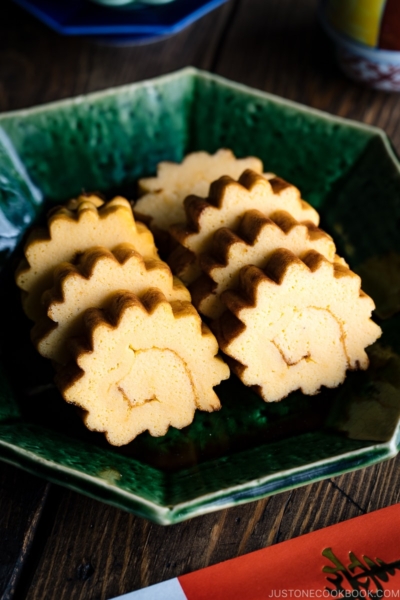
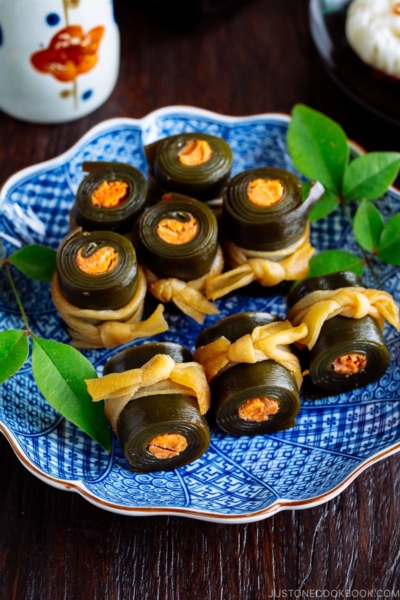
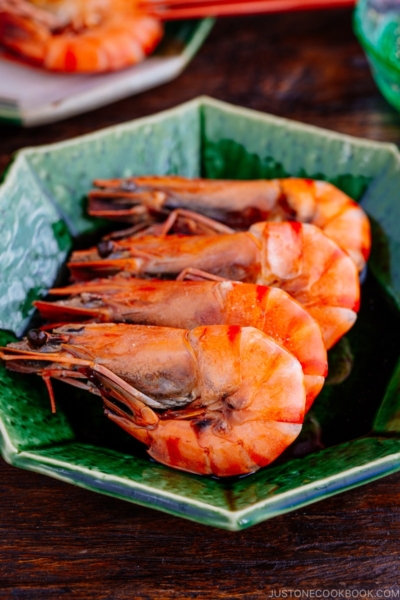
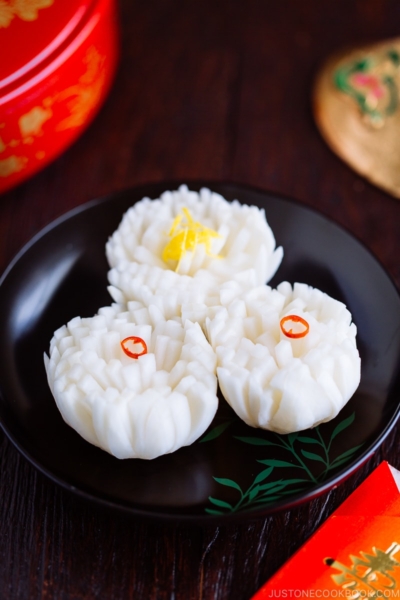




I used a 10.5 oz package of kuromame and had very little sauce left. Any adjustments for this amount of beans?
Hello there! The weight ratio of black soybeans, sugar, and water is 1:1:6.
Do you believe you added enough water? If so, the water is probably evaporating too quickly. If the bean tastes delicious, you may keep it as is. You may also add the same ratio of water, sugar, soy sauce, and salt and simmer for a few more minutes until all the sugar has been dissolved.
We hope this helped!
After buying kuromame ready made at the Japanese supermarket year after year, this year I decided to be ambitious and try your recipe because the supermarket sold out on the ready-to-eat ones that I usually buy and only had the bag of uncooked beans available. Being superstitious if I don’t have the kuromame for the New Years meal, I decided to try your recipe. Oh was it worth it! So much more delicious than the store bought ones. Thank you so much! I followed your exact instructions so as not to end up with mushy beans or “bleached” looking beans, and they are not “super sweet” like the store bought kind. I have now become a convert to home cooked kuromame thanks to your recipe.
Hi Mari! We are so happy to hear you enjoyed homemade Kuromame as much as we do! 👏🏻
Thank you for trying Nami’s recipe!
PS I use a cast iron pot to cook it in so I don’t need the iron fish and it comes out glossy and beautiful! I appreciate the tips so as not to have beans that turn to mush or fall apart.
Hi KPFukuda! That is a great idea! Thank you for sharing it.
Happy Cooking!
I love this recipe, I’ve followed it year after year for osechi ryori preparation and it’s a family favorite! Not too sweet not too bland.
Hi KPFukuda! We are glad to hear you enjoyed Nami’s recipe!
Thank you for trying her recipe and for your kind feedback.😊
I made these last new-years and everyone loved them!! Last September I was in Japan again and bought a big bag of those beans and a cute metal eggplant shape for the black color (last year I used rusty nails 😄). So this new-years these will be on my table again. Great recipe, great success. Thank you
Hi Ina! Wow! That is wonderful! Thank you very much for continuing to use Nami’s recipe this year!🤗
Since the elders in our family love this dish, but usually buy, I decided to try out this recipe and give it a shot. Even if I don’t have the iron fish (yet) to make it really black, they think it’s definitely dark enough and love that it’s not as sweet as their store bought versions. Even if this means one more dish that I’ll be making for new year’s gatherings, it’s well worth it. Thank you so much!
Hi Kelli! Aww. We are so happy to hear you enjoyed Nami’s recipe!
Thank you so much for trying her recipe and sharing your experience with us. 🤗
I tried these for the first time at a hotel breakfast buffet in Tokyo over the New Year holiday. I love beans, especially black beans, so I took a big scoop and was surprised to find they were not the savory black (Latin American style) beans I was expecting! I enjoyed them so much I had a second serving. I wasn’t sure what they were but after some research I came across Nami’s recipe and decided to give it a go (iron fish and all) and they came out just like the beans I had at the hotel! I should note that I did let them rest for the full 8 hours.
Like some other reviewers posted – this recipe makes a lot of beans and I wasn’t sure what to do with them all so I decided to try the steamed cake recipe Nami suggested (in this recipe) and wow they were so good! I think I’ll also try adding them to pancakes 🙂
Thank you Nami!
Hi Mercedes, Thank you so much for trying Nami’s recipe and sharing your story. Your steamed cake also looks delicious! 🤩
We hope you enjoy Kuromame pancakes as well. Enjoy!
Are these the right kind of black soy beans? Or are these used for something else?
The picture didn’t seem to attach- but they say black soya beans and the back has directions for black bean wine.
Hi Kenzie! We are not sure which black beans you have without looking. But if it shows “Black Soya beans”, it same as Black soybeans.
https://www.justonecookbook.com/black-soybeans/
We hope this helps!
My mom is so impressed by the kuromame I make each year, courtesy of your recipe! I was just wondering if you always use regular white sugar or if you ever use the Japanese brown sugar (I think with the cherry on the bag?).
Hi Noe! Thank you very much for trying Nami’s recipe and for your kind feedback!
Yes. If you prefer, you can use brown sugar to make Kuromame. The flavor will be a bit different.😉 Some people use brown sugar to help make Kuromame’s color. However, rusty iron nails (the traditional method) or Iron Fish will give you a better result.
We hope this helps!